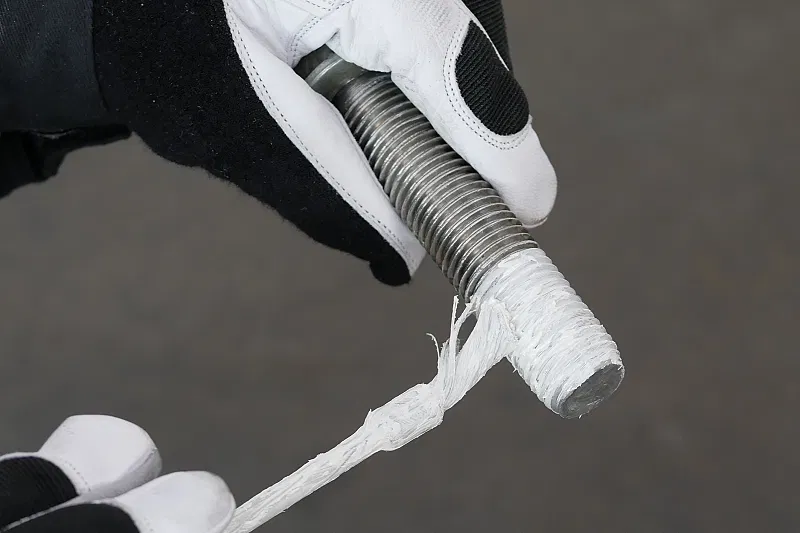
Access to prices and online shopping
Overview of your purchased items
Contact your sales representative and clerk
Educational materials
News about industrial seals
Information on new products and services
Exclusive hints and tips
Fill in your contact details and we will get back to you as soon as possible.
We will call you at your chosen time and advise you on what you need.
Our sales and technical representative will come to your company for a personal consultation.

The bolted joint has its own specifics. Throughout the tightening process, the bolt connection is stressed for tension, torsion and possibly for flexion. As the preload increases, the pressure in the contact surfaces increases.
These basic assumptions should be used as a basis for the selection of a lubricant for a conventional bolted joint.
There are many lubricating pastes that are claimed to have a low coefficient of friction. However, a low coefficient of friction in itself does not guarantee anything. It must also be taken into account how it was measured and according to what standard.
The coefficient of friction is not a single number. It is necessary to know its trend and variance depending on the load during tightening of the bolted joint.
The friction coefficient of a bolted joint is tested according to EN ISO 16047, which specifies the conditions for torque and clamping force tests on fasteners.
The value of friction given by the manufacturer based on another method of measurement, e.g. four-ball test or Pin-on-Disc test, is misleading for the calculation of the tightening torque.
These tests do not determine the friction in the thread or under the nut, including their dispersion. Neither the total friction nor the tightening factor, the k-factor, can be derived from them.
The actual friction value measured by a method other than EN ISO 16047 varies significantly.
* Four-ball test: Method for measuring the coefficient of friction for oils and lubricants. The load resistance of the lubricant and a general index of abrasion are evaluated. It is divided into the ASTM D 2596 weld test and the ASTM D 2266 wear test. ** Pin-on-Disc: Measurement consists of pressing a firmly attached ball-shaped test body (PIN) into a test specimen (disk) with a predefined force.
Customers often contact us to calculate the tightening torque. They then want to tighten the fastener with their own forces and using their own lubricant.
In view of the above, we take control measurements of friction coefficients, including their dispersion, for lubricants that we have not historically measured. Thanks to our own laboratory, in which we carry out the measurements in accordance with EN ISO 16047, we subsequently have accurate and realistic friction coefficients for individual lubricants over the entire range of permissible bolt loads.
Based on the hundreds of measurements we have made, we can say that in many cases the real friction coefficients differ from those commonly available in the material data sheets. The differences can be as much as tens of percent and are often caused by just different measurement methods.
When tightening the flange joint itself, the same lubricant that was considered in the calculation should always be used. Otherwise, the individual bolts may be over- or under-tightened and the seal may be under- or over-compressed.

The \{#producttitle\\}}}134\{{/producttitle\}} is a solid paste lubricant with a low and steady coefficient of friction designed for conventional bolted joint assembly.
After mixing, the lubricant is applied with a brush to the threads, washers and nut faces or under the bolt head. It forms an effective lubricating film between the friction surfaces separating the screw thread and nut from each other. As pressure builds up on the thread contact surfaces and under the nut head, the coefficient of friction does not change, see chart.
Bolt connections are cold tightened as standard. The temperature resistance of the lubricants rather gives an indication of their ability to ensure subsequent loosening of the bolted joint. The temperature resistance test of a tightened bolted joint with paste \{#producttitle\\}}}134\{{/producttitle\}} was carried out after heating it to 600 °C and subsequent cooling.
To give you an idea, here is a comparison of the friction curves of the bolt unlubricated, lubricated and tightened with paste \{#producttitle\\}}}134\{{/producttitle\}}.
Comparison of friction coefficients of LF Booster lubricating paste, high-temperature metal-based paste and lubricant-free screw joint.
 From the graphs above, the coefficient of friction is constant for \{#producttitle\\}}}134\{{/producttitle\}} lubricant throughout the entire allowable bolt load, which is not the case for standard metal-based pastes. A coefficient of friction that varies over the bolt load is not desirable.
From the graphs above, the coefficient of friction is constant for \{#producttitle\\}}}134\{{/producttitle\}} lubricant throughout the entire allowable bolt load, which is not the case for standard metal-based pastes. A coefficient of friction that varies over the bolt load is not desirable.
As friction worsens, metal-to-metal contact occurs at the thread contact surfaces. This phenomenon in the bolted joint subsequently causes seizure and places additional undesirable torsional stress on the bolt. The required preload in the bolt cannot be achieved during tightening.

© Pokorny industries s.r.o. 2025 - all rights reserved
Made by servisdesign
You don't know what to do?